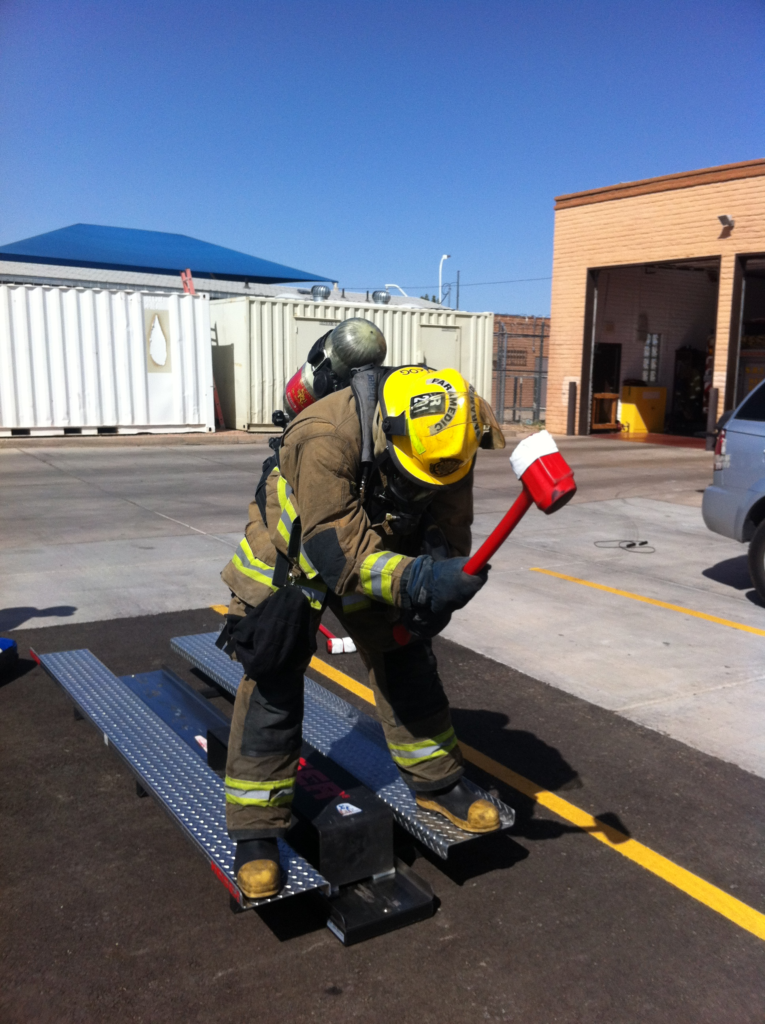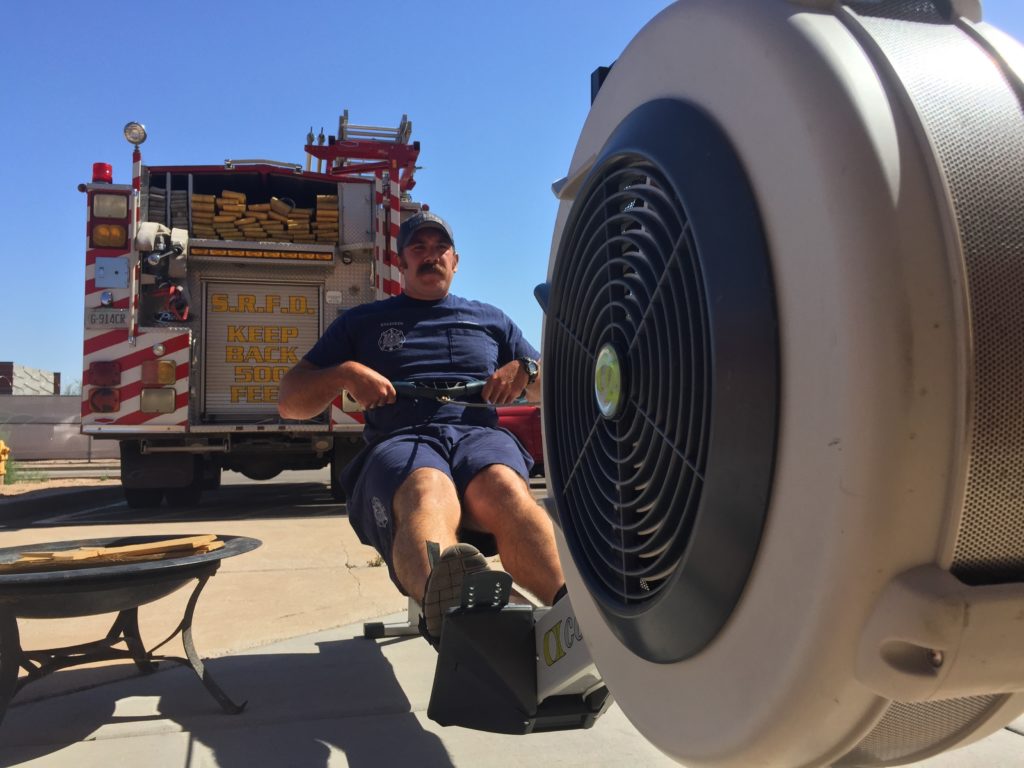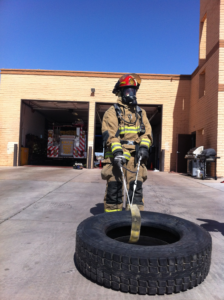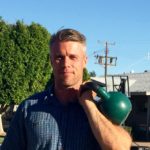Goal # 4: Build your Engine – The Ability to Do More Work in Less Time
Chris Adams

Work capacity is easily relatable to fireground operations at the task level. As a firefighter you are an “industrial athlete”; an individual who makes a living completing physical objectives with quickness and efficiency. As dramatic as it sounds, your life, the lives of your brothers and sisters, and the lives of the public may rely on your ability to do your job well. Admittedly a truly dire operation happens rarely with the bulk of our calls being “ordinary”. But the potential still exists. And we train for low frequency high-risk calls.
As mentioned in part 3, maximal strength is an important component of reducing the relative difficulty of work capacity. However, when repeating a movement over a period of time the ability of the cardiovascular system to supply the muscles with oxygen and remove the by-products of muscular metabolism becomes extremely important. The more efficiently you can do this, the longer you can work at a lower perceived effort and the more efficiently you use the fuel substrates that you have stored in your muscles and adipose tissue. What does this mean in plain English? You can work longer, easier, and recover better during and after intense activity.

Step one: Building an Aerobic Base.
Aerobic base building is relatively easy. Here’s a simple format that I’ve used for ABB.
45-60 min of easy activity (at a heart rate of 55%-75% max HR) 3-5 times per week.
That’s it. Pretty simple right?
If you enjoy it, go ahead and go out for an easy run (if you’re training for a fire academy, this is probably a good idea anyway. As many fire academies make extensive use of running. I don’t agree with this idea but that’s another article entirely). Not a fan of running? Get a bike and go for a ride. Take a hike up a hill. Develop a swimming practice. I encourage you to mix up your activity as much as possible. This way you keep it fresh and reduce the incidence of over-use injury.
The good news is while the activity needs to be relatively continuous it doesn’t have to be monotonous. In fact, you’ll get even greater benefit from mixing things up. Here’s an idea that’s one of my favorites because it’s simple and adaptive.
Choose 2-5 weightlifting or gymnastic movements and a cyclical (cardio) movement. Here’s an example.
As many rounds as possible in 45 minutes @ HR below 148
- 800 M jog (cyclical)
- 3.3.3 heavy kettle bell swings (weightlifting. 3.3.3 means a cluster of 3 reps with about 15 seconds rest between each cluster. The focus is on exposure to a heavier weight.)
- 15 pushups – 3 seconds down and explode up hold 1 second and top and bottom (gymnastic)
- 10 unilateral KB weighted walking lunges (weightlifting)
Let’s break this down so you get a better sense of you how can create this on your own.
For the cyclical movement, I like to use a time range of anywhere from 2-5 minutes. Any cyclical movement, or several, can be used in a single workout. I’ll often switch from one to another mid workout just because I’m getting bored. For the purposes of the session that’s okay.
For example I’ve used
- 400-800 M run
- 500-1000 M row
- 40-100 calories on the air dyne
- 2-5 kilometers on an exercise bike or real bike
- jumping rope 2-4 minutes
- walking 15-30 flights of stairs
- incline walking at 8%+
For the weightlifting/ gymnastic portion I like to choose a rep range that falls into the “easy” to “moderate” category. This means that you can easily perform several sets of the given movement before reaching muscular failure. It’s been my experience if you consistently use an easy rep range your muscular endurance will still improve. Over time you’ll find that the “easy” rep range is increasing.
You can also work more specific job related conditioning into the mix. For example I’ll use:
- big tire flips (low rep)
- weighted carries (25-50M is often good. Although I’ve used as much as 400m)
- drags (25-50m)
- hose pulls
- hose hoists
- crawling drills (20-25m)
- ladder carries
- ladder raises
- hammer swings (or ball slams and variations to save your joints
And the list goes on. You’re only limited by creativity. Keep in mind that anytime you’re working something involving skill that it’s more important to do it right than with intensity or volume. think “practice”. I can’t reiterate enough that you should keep the volume of reps low enough that you’re not hitting technical or muscular failure. Especially for skill related movements.

In the same sense, mobility work is an excellent addition to the long slow circuit. Your muscles are warm and contribute to improving mobility. Mobility is also a great way to cool the heart rate a bit between movements that might have you hitting your aerobic threshold.
Ruck marching
Ruck marching is another excellent activity to work at the ABB pace. Load up a pack with some weight and go for a brisk walk or hike. It has the double bonus of conditioning your body to work for long periods with an external weight loaded on the body. This is something you need to get used to if you’re going to be working in structural or wildland firefighting. Hiking over uneven terrain improves the functionality ruck marching even further.
How does aerobic base building work?
Get a heart rate monitor – The heart rate monitor is a valuable tool. If you go all out, all the time you need to learn how to go slow. Get it! Use it! The ones with the chest strap are the best, as they’re the most accurate. It’s easier to use a HR monitor that can alert you to specific heart rate zones, but it’s not necessary. As you become accustomed to the pace the heart rate monitor will be less important. But in the beginning it’s critical and remains useful for tracking progress and checking in from time to time.
Joel Jamison, an expert on MMA conditioning, suggests that your goal should be to maintain a heart at 55% -75% of your maximum heart rate. For most people this is about 120-150 beats per minute. Phill Maffetone, another expert in the field, suggests using 180 – age. If you’ve been sedentary, subtract 5 beats and if you’re highly trained add 5, and if you’re train regularly, for fun, then stay at your first calculation. This puts you in the aerobic range and actually seems to work fairly well as a general guide. You can get more specific with numbers if you want to geek out but both of these guidelines tend to be good enough for our purposes.
Start your session slowly and build a little intensity as you go. As your heart rate hits the aerobic limit, slow down – So, if you’re say, running and you hit your limit slow your pace or even walk until your HR drops about 20 beats then pick up the pace and repeat. What’s often frustrating is that a glycolytically conditioned athlete (all high intensity all the time) will often start and stop constantly. This is a sign that the aerobic system has been neglected. It also means there’s a high potential for improvement through aerobic training. Over time, you’ll find that you have to stop and walk less and less and that you’re even moving faster than when you first started.
The same goes for the gymnastic/weightlifting/skill movements. If you’re heart rate hits the limit stop what you’re doing and walk it off until drop about 20 beats back into range. Then continue the process. You might find that some movements are more conducive than others for this type of training session as there are movements that can easily jack up the heart rate when repeated for reps.
I suggest working on an aerobic base building phase for 1-3 months. If you’re a beginner then 3 months is enough time to create positive adaptations and build work capacity. If you’ve got some time under your belt then adding in a one month aerobic phase is a great way to reduce intensity and allow your body some recovery. Once you build a base, ABB is something you can do pretty much every day without too many repercussions.
Finally, remember that at this pace, the work is going to feel easy. You won’t feel spent when you’re done. In fact, you might end up feeling better than when you began the session. This is where it’s hard for someone used to going 100% all the time. I’ve seen and trained several guys who are addicted to intensity. I was one of those guys at one time. It took self-discipline to slow down. It was worth the effort.
Testing
As with other fitness qualities, test and retest to assess improvement and the efficacy of your training program. Testing ABB is easy. Choose an activity and see how far you can make it over a twenty minute timeframe while keeping your heart rate in range. Next time simply repeat the test.
Markers for aerobic improvement:
• Increased work over time – At first you might notice that you’re constantly hitting your heart rate ceiling. However, as you build time in training you’ll find yourself moving at a constant pace. Part of this might be just learning how to slow down and relax. As your body because better adapted for aerobic training you will be able to sustain a higher work output without having to slow down.
• Decreased resting heart rate – Improving your aerobic efficiency causes an increase in the elasticity and therefore volume of blood that you heart pumps per stroke. This means your heart can pump more blood with less beats per minute. A decreased resting heart rate is also a positive marker for health and longevity. A good general goal is a resting heart rate less than 60.
• Increased recovery heart rate – A better aerobic base allows your body to quickly clear metabolic waste and deliver nutrients to your muscles. More aerobic efficiency means better recovery in less time. Take your heart rate immediately after very intense activity and then exactly 2 minutes later. The difference between the two numbers is your recovery heart rate. Higher is better. A score of 20-30 is good and a score over 30 is excellent. Heart rate recovery is another measure that’s directly correlated to health and wellness.
• Increased heart rate variability – Measuring HRV is gaining popularity as a training tool. HRV, measured through a heart rate sensor and smart phone app, gives you a simple look into the state of your nervous system. Simplistically a high HRV is a healthy HRV. It means your heart is responsive to challenges. A low HRV can mean that your nervous system is “stuck” in fight or flight; you’re stressed. Aerobic base building activity is known to decrease sympathetic tone and stress and improve your HRV score. The higher your HRV, hypothetically, the better your nervous system at handling stress.
• Decreased stress – This one’s less easy to quantify but here’s the idea. High intensity exercise is stress inducing. In order for your muscles to utilize it’s stored glycogen, the fuel used in high power short duration activities, your sympathetic system is activated. In acute bouts of stress this isn’t a problem and is actually beneficial for adaptation and health. Chronically activating your sympathetic system is detrimental when combined with decreased recovery, improper nutrition and increased stress (Those 3 factors pretty much sum up what you’ll regularly be exposed to as a firefighter). Activity in the aerobic range is much less stress inducing and in fact when done in short sessions can help alleviate stress and aid recovery. Pay attention to your daily mood before and after adding in specific aerobic activity. Does the addition of ABB decrease your overall stress? Are you sleeping better?
Aerobic base building is an excellent tool that has become under utilized in today’s fitness world. It’s not sexy and doesn’t scream “beastmode” but don’t be fooled. A firefighting beast has a strong aerobic base. ABB has beneficial effects for performance and health, doesn’t lead to loss of muscle mass, and can help you recover from training, and make you a stud on the fire ground.
Step 2: Build Intensity
After developing an aerobic base, it’s time to turn your foundation into performance. Building maximal aerobic power is the next step in the process.
We move from long time frame and easy intensity to short (compared to ABB) burst windows with some heat added in. These are called maximal aerobic power sessions (MAP). While MAP sessions are “high power” they are not 100% effort. I want you to think about reaching the 80-90% window in terms of effort. You should be tired and breathing hard but not smashed. Save that for the testing days.
A good way to measure the correct intensity is to look at the rest periods and the work output.
Rest/work intervals:
Just as in strength training, our goal in MAP is to perform several bouts of exercise that, when added together, form enough stimulus for adaptation. You can look at each interval as a rep and the total number of intervals as sets.
Generally we’re looking at 3-5 reps for a training effect. However, just like weight training, a smaller time under tension might need more reps. For instance, it’s realistic to program up to 30 reps of 30 seconds work.
For maximal aerobic power, our rest compared to work should be relatively short. Generally 1:1 or 1:2 work to rest ratio. It’s important to keep the rest intervals short and exact in order to get an idea of correct work output.
Work output
For a given set of reps, work output needs to be consistent. Practically, your times should be as fast or faster as the reps progress. Exact rest is important because it can identify if you’re going too hard or not hard enough. If your work output decrease more than 5% you’re working too hard and/or not recovering enough to continue.
For example let’s say your running for 800 meters and resting for 3 minutes for a total of 5 repeats.
Your scores: 3:05, 3:06, 3:00, 3:30, 3:36
Notice that the first three reps are right in line with consistency of work. But at rep four the work noticeably decreases. This is where you stop for the day. You’re no longer recovering in the time frame given. If you follow this rule I can almost guarantee you’ll make progress without putting undue stress on your body.
If instead your times looks like this
3:05, 3:06, 3:00, 3:00, 2:54
You know that you can push a little harder next time and shoot for a lower overall score.
Frequency
I suggest performing MAP sessions 2-3 times a week depending on ability to recover and other training considerations.
Work Timeframe
The good news is that MAP tends to be much shorter in length compared to aerobic base building sessions, which need volume to stimulate adaptation. I suggest a total work time of 10-30 minutes not including rest.
What this might look like:
4-8 x 2:00 rest 1:1
3-5 x 3:00 rest 1:1
5 x 5:00 rest 3:00
2 x 10:00 rest 5:00
These are just examples in no particular order. Feel free to create your own.
When programming your intervals keep a couple things in mind.
• Structural firefighting generally falls in 15-20 minute work cycles with about 5-10 minutes rest between cycles. So this is the work output timeframe you generally want to train for.
• Use the minimum effective dose. Error on the side of less work instead of more. At least until you have a good handle on how you respond to training.
• Follow consistency, intensity the volume for progression. This means build consistent work, decrease rest intervals and then increase the number of reps.
Endurance Standards
• Ability to run a 5K (3.1 miles) without having to stop (at any pace)
• 1.5 mile run for time: 12:00 or less (8 minute mile). I would consider 9:00 or less to be excellent with good falling somewhere in between.
• 2000 K row of less than 7 minutes. (this is somewhat dependent on bodyweight. A heavier individual will want to shoot for a lower time)
• 50 burpees for time: 4 minutes or less
• As many rounds as possible in 12 minutes of 10 wallballs and 5 burpees: 8 or better.
• A passing score in the physical aptitude test used in your region.
Note: these tests are somewhat arbitrary and represent what I’ve found to be good measures of endurance in a short, medium, and longer timeframe. You could easily build your own benchmarks. For instance: climb 50 floors wearing full gear and breathing air for time.
Final Thoughts
I’ll leave you with one final piece of advice. Be realistic. Developing a solid fitness foundation may take time. If you’ve spent years sitting at a desk it might take you years to improve your strength, endurance. And mobility.
Even so, begin your testing process as soon as possible. Don’t wait till you think you’re ready. Jump in with both feet and be prepared to learn from your successes and failures. If you commit to the process you will improve. You will be the next generation firefighter.
 Chris Adams is a firefighter/paramedic with 15 years of service to the Salt River Fire Department in the Pima-Maricopa Indian Community. When Chris isn’t reading, learning, or blogging about fitness he enjoys rock climbing, canyoneering, and exploring in the American Southwest.
Chris Adams is a firefighter/paramedic with 15 years of service to the Salt River Fire Department in the Pima-Maricopa Indian Community. When Chris isn’t reading, learning, or blogging about fitness he enjoys rock climbing, canyoneering, and exploring in the American Southwest.

Hi Chris, awesome article(s). Curious, you mentioned you’re not totally in favor of running for Fire Academy , why is that and what alternative would you choose were it up to you?
Cheers
Funny I’m just now noticing these comments. I was actually googling aerobic fitness and firefighting and this article popped up on the googles. Then I noticed there were comments. So sorry it only took me three months to get to your question Tom.
So here’s why I’m not a big fan of running for the academy. I’m not against running by any means. I think that it’s a good form of exercise (when not taken to extreme… admittedly I don’t have a good exact definition for “extreme… but I digress). I think it’s something that we should be able to do as human animals. It’s something that we should maintain through life if we can.
Running is not specific to firefighting operations. We don’t typically run on the fireground. in fact we’re often taught that running on the fireground is a safety hazard and that we should “walk with a purpose”. So, when we’re training running, it’s not because it’s specific to what we do. Therefore it’s a training tool. As a training tool it’s not without risk. Running is one of the biggest contributors to fire academy injuries, which are generally overtraining related.
I think that we can train base fitness using fireground specific exercises without resorting to high volume running – which increases the risk of injury over time.
So to sum up….
running ins’t bad but…
running can increase the risk of injury when given in high volume doses..
there are better alternatives which are more specific to fireground operations…. and more interesting.
Does that answer the question? Any thoughts about it?
Running is not specific to fireground activity. Therefore it’s a training tool. It contributes to many overuse injuries IMO. I think we can build base fitness using fireground specific activities. This keeps things interesting and breaks up movement patterns. That being said I think that running is fine as a limited tool for fire academy training. Running is fine as a hobby if the individual tolerates it well.
Was unaware of the differences in effect aerobic vs HIC has on the sympathetic nervous system….thought cardio was cardio. In hindsight that explains a few things in my trg!
Hey Chris, would SE circuits count as an aerobic base builder? Seems like it might fit your guidelines for non-monotonous activity?
Not Chris, but one way to find out would be to monitor your HR during SE and see for yourself. The answer’s probably different for everybody.
Hi Kieran ….. I’m going to say I lean towards “probably not” – Even if a person’s heart rate remains in the “aerobic zone” ( this in itself is specific to the individual)
If you look at what’s going on in the working muscles, the contractions are too slow to maintain an aerobic environment. You need a quicker contract/release cycle to allow aerobic respiration to be effective.
How does SE affect the heart? I’m not real sure to be honest. Is a person getting the general endurance component from SE? Maybe. that might depend on the individuals conditioning as well. Someone who’s “unfit” will probably get more general aerobic benefit than an aerobically fit individual. But SE doesn’t have enough consistency of cardiac contraction to garner aerobic benefits on a trained individual.
Does this mean you shouldn’t add SE exercises into a general endurance session? Not at all. I think there’s a huge benefit to sessions that mix it up. It keeps it interesting and unless a person is training for something specific, like a marathon, then they don’t need to be so focused anyway.
I do know, practically, that SE goes very well with aerobic base building. They compliment each other well. Which is obviously why KB puts them together in his program.
I hope that helps.
Well written dude, thanks.